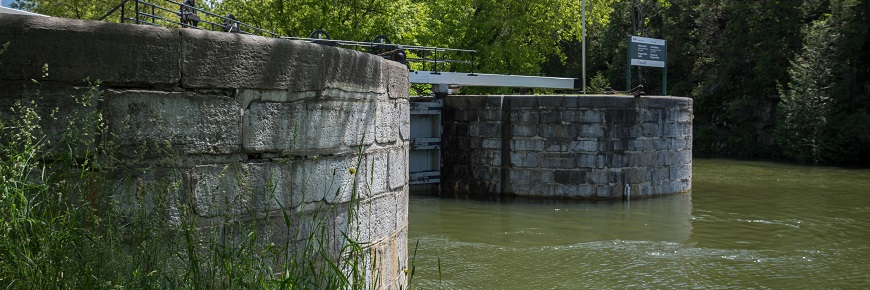
Kingston Mills Lockstation - A walk into the past
Rideau Canal National Historic Site
Kingston Mills, one of 24 lockstations on the Rideau Canal is a prime example of engineering mastery and military history. Each of the four limestone locks has a lift of 3.6 metres and they utilize all three manual methods of opening and closing the lock gates. The only other lockstation to exhibit the push bar, swing bar and endless chain mechanisms is Ottawa Locks. The cost of construction, 60,000 £, was only surpassed by Jones Falls and Ottawa lockstations.
Before construction of the Rideau Canal at Kingston Mills, the Cataraqui River wound through low-lying marsh, then fell 5 metres over a granite ledge into a deep rocky gorge, making this location an ideal site for a saw and grist mill complex.
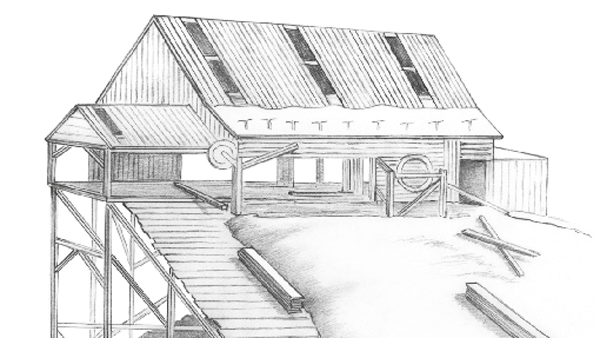
Saw and grist mills built by Robert Clark, a Jessop Ranger from New York, were erected in 1783-84 by the British government. The area became known as King’s Mill. All residents were required by law to bring their produce to these mills, which served the entire district from Elizabethtown (Brockville) to the Bay of Quinte, a very large area described by one officer: “No road being opened, they had to cut their way through the woods in the best manner they could. But there was little snow on the ground, and the rivers were frozen over. After a fortnight’s (14 days) absence the men returned, having affected their object, but without much benefit: for they and the horses, during their absence, had consumed the greater part of their loads. None of the settlers here are so far from a mill, yet some of them are from ten to twenty miles; and, till the roads were opened, they had to carry the grain all that distance on their backs.”
Robert Clark’s son, John, recalled the mill was constructed out of “log or roughly squared timbers.” Over the years, various grist and saw mills suffered a variety of fates, such as fire, abandonment, water damage and resource depletement. The last grist mill on site was damaged in 1905 by the spring freshet and afterwards crumbled away. Today, the water power generation plant continues to provide electricity, as it has done since its creation in 1914.
The original water power plant supplied DC power. In 1924, AC power was introduced, graded to generate 2,400 hp.
The post 1856 sketch shows the mill (1) below the locks in the original Cataraqui River channel. Its appearance is much different than the 1830s mill illustrated. A long wooden bridge (2) leads east away from the blockhouse (3) towards the village of Kingston Mills. The wooden bridge was replaced by a cement dam and weir, creating a new basin that hides the stonework of the original dam (4) and the waste weir (5). The dam and waste weir are used to control water levels of Colonel By Lake and the supply of water to the hydro generation plant’s turbines.

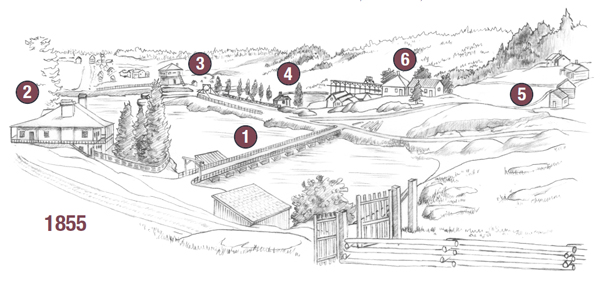
Kingston Mills, post 1855
The 1855 sketch features a footbridge (1) crossing a bay on Colonel By Lake leading to Robert Drummond’s, the contractor’s residence (2) in which the lockmaster lived after the locks were completed. Other structures include: the blockhouse (3); the Cataraqui Section Headquarters building (4) erected in 1831 where the Anglin House now stands; and the office of Lt. Brisco, a schoolhouse, workshops, and bunkhouses (5).
Many of the buildings’ functions changed between the canal’s completion and 1855. In 1855, construction of the Grand Trunk Railway Wood Truss Bridge (6) was underway. It would connect Montreal to Toronto for the first time. The double track, fixed three-span railway bridge was built in 1929 by the Canadian National Railroad. The two abutments of the bridge and the pier adjacent to the combined locks are dressed stone and are part of an 1890 bridge.
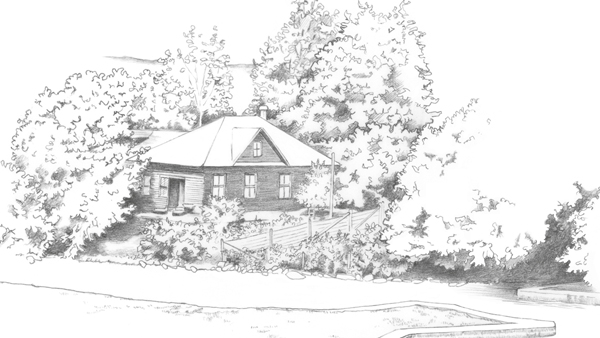
Cataraqui Office - The head office building for the Cataraqui section of the canal, 1832-1904.
The 1832 painting by paymaster William Clegg shows the complete lockstation. The mills (1) are shown in a different location than the 1856 sketch. To the west of the blockhouse (2) is a drawbridge (3). It was a balanced, double-leafed drawbridge with two identical lift spans forming an arch over the centre of the lock. Two pairs of pivoting balanced arms were chained to the two leaves to provide lift. It was first replaced with a King Post Swing Bridge, similar to the bridge located upstream at Lower Brewers. Later, a modern steel swing bridge was constructed. Most notable is the size of the turning basin (4).

Today, the basin is considerably smaller than originally constructed. The basin was a transfer point for goods and materials during the 1830s and 1840s because of a large sandbar below Kingston Mills that was referred to as the “Shallows”. This sandbar prevented some ships from passing safely along on their journey. On the northern edge of the basin (5) was the head office building for the Cataraqui section of the canal. It was removed in 1904 to build a lockmaster’s residence that also contained a post office at the same time until 1946. Today, it is an interpretative and orientation centre for the Rideau Canal.
The Rideau Canal is one of the world’s finest examples of slackwater construction. During the creation of the canal, a series of dams and embankments were built to raise the water levels 1.5 metres for safe steamboat navigation. Kingston Mills boasts the longest stretch of combined embankments and dams. The western embankment stretches 805 metres, acting as an interface between the Frontenac Axis (an extension of the Canadian Shield) and the Napanee limestone plain, that included a marsh and abandoned quarry site. To the south, the granite outcrops of the Frontenac Axis were one of the greatest obstacles in the construction of the Rideau Canal. The use of black powder to remove this extremely hard rock resulted in numerous deaths and injuries throughout the waterway.
Malaria was another chronic problem during the creation of the canal. In the summer of 1828, Captain Savage wrote: “At Kingston Mills, Lieut. Briscoe Roy Engr, the Asst. Overseer, the Contractor, his Clerk, Foreman, and nearly the whole of his men [about 100] have been attacked, the Clerk and 12 men have died, Lieut. Briscoe still continues extremely ill, with the lake fever.”
The blockhouse is one of four constructed on the Rideau Canal. Its architecture is a typical design utilized throughout British North America. The 7.3 metre square building has 1 metre thick walls designed to withstand small canon fire and a pyramidal tin sheathed roof to endure fire and Canadian winter snow. The upper level overhang, derived from mediaeval fortifications, allowed for machicolated defence (holes cut in the overhang permitting downward fire on the enemy). The loopholes cut in each hewn square timber wall were long and narrow but tapered within, allowing the defender a greater angle of fire. After its completion in 1832, the building was garrisoned continuously by British regulars and militia from July 1838 to January 1841 because of increased tensions with the Americans and interior strife caused by the Upper Canada Rebellions. This building could garrison up to 20 men. Today, the blockhouse is restored to its original condition and is furnished as it might have been in the 1830s.
At one point, a labourer and his family occupied each storey of the blockhouse. The other men spent the navigation season in an 1881 constructed wooden structure referred to as the “lodge”. This one and a half storey frame building, located close to the blockhouse, was 5.5 metres by 4 metres. Each level of the building consisted of a single room. The “lodge” was demolished in 1972.
The present-day lock office, once a storehouse, is one of the last survivors of a group of service buildings at Kingston Mills. Many other buildings disappeared over the years, including storage barns, stables, shanties, railway buildings and possibly a blacksmith shop located in the vicinity of the lock office.
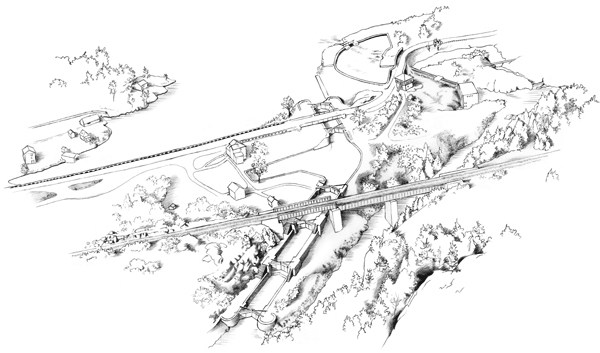
Related links
- Date modified :